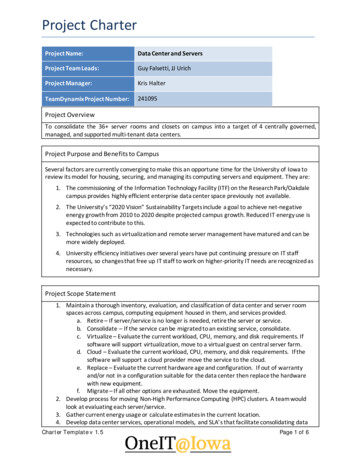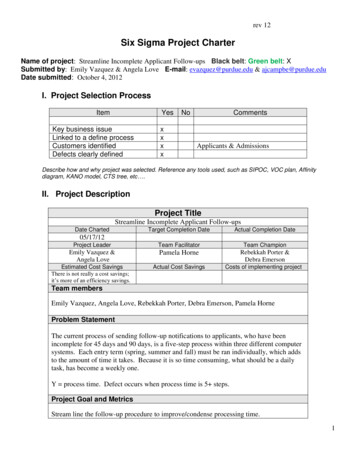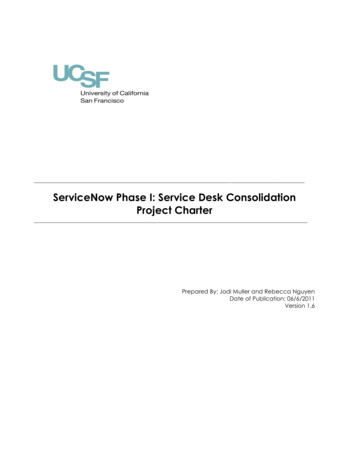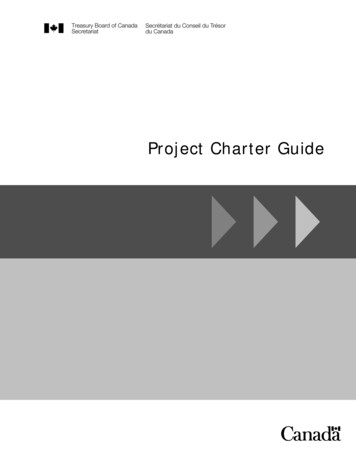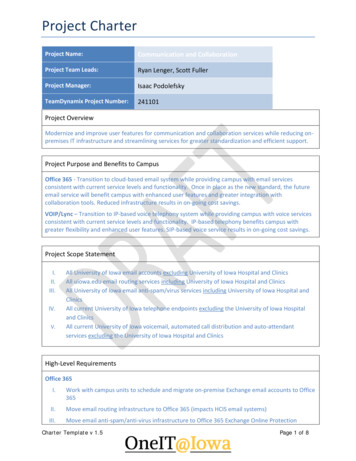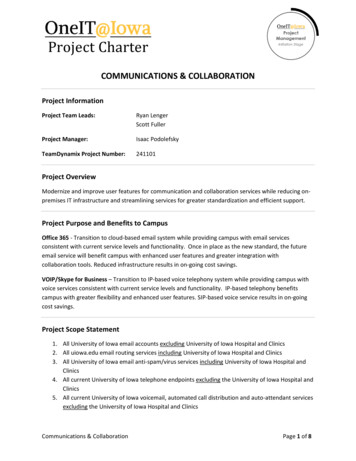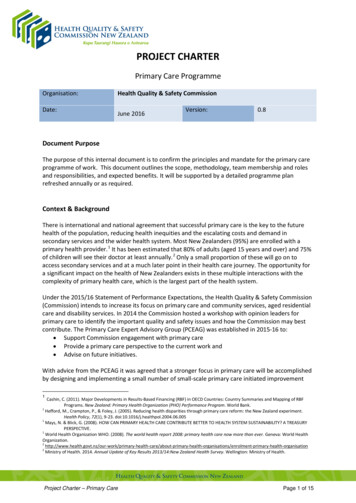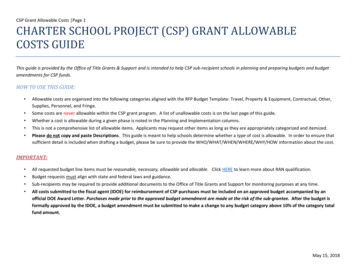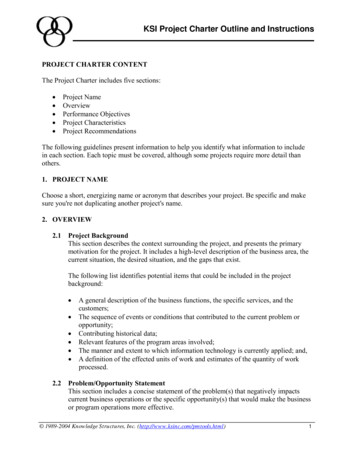
Transcription
KSI Project Charter Outline and InstructionsPROJECT CHARTER CONTENTThe Project Charter includes five sections: Project NameOverviewPerformance ObjectivesProject CharacteristicsProject RecommendationsThe following guidelines present information to help you identify what information to includein each section. Each topic must be covered, although some projects require more detail thanothers.1. PROJECT NAMEChoose a short, energizing name or acronym that describes your project. Be specific and makesure you're not duplicating another project's name.2. OVERVIEW2.1 Project BackgroundThis section describes the context surrounding the project, and presents the primarymotivation for the project. It includes a high-level description of the business area, thecurrent situation, the desired situation, and the gaps that exist.The following list identifies potential items that could be included in the projectbackground: A general description of the business functions, the specific services, and thecustomers;The sequence of events or conditions that contributed to the current problem oropportunity;Contributing historical data;Relevant features of the program areas involved;The manner and extent to which information technology is currently applied; and,A definition of the effected units of work and estimates of the quantity of workprocessed.2.2 Problem/Opportunity StatementThis section includes a concise statement of the problem(s) that negatively impactscurrent business operations or the specific opportunity(s) that would make the businessor program operations more effective. 1989-2004 Knowledge Structures, Inc. (http://www.ksinc.com/pmtools.html)1
KSI Project Charter Outline and InstructionsAvoid describing the symptoms of the problem instead of the problem itself. Symptomsthat may seem to be the problem include: Processes that are old, confusing, convoluted, redundant, labor intensive,undocumented, or nonstandard;Data that is incorrect or incomplete;Data that requires excessive effort expended in collection, multiple collectionpoints, or different versions of the truth; and,Technology that has incompatible hardware/software, outdated hardware/software,ineffective use of automation, or too many manual processes.The symptoms of a problem are important in that they help lead to a solution. However,symptoms alone are not enough to justify a project. To make sure that you have reachedthe real problem, ask yourself “So what?” for each item you have included as aproblem. If you have identified a business problem or opportunity, your answers shouldfall into one or more of the following categories:Problems Excessive costs incurred in operating an existing programGeneration of additional program costsServices at an unsatisfactory level according to a specified policyWorkload/staff increasesQuality or timeliness of informationAdditional requirements mandated by law or Federal regulationsLimitations on the capability or capacity of current resourcesThe following are example problem statements: Current system cannot provide statistics of UI claims filed on Fridays.The current process requires 3.6 PYs of overtime to process travel claims.The current hardware system is obsolete and may fail within the next six months,meaning that the department will no longer be able to process revolving fundchecks in a timely manner.Opportunities Avoidance of future operating costsImproving mission critical customer servicesWorkload/staff reductionsAbility to add capacity to current resourcesThe following are example opportunity statements: 1989-2004 Knowledge Structures, Inc. (http://www.ksinc.com/pmtools.html)2
KSI Project Charter Outline and InstructionsTransferring the system to the network allows standard access throughout the statereducing support needs and providing more rapid response to customer requests. Installing the automated call center allows the department to continue with thecurrent staffing level and improve service, even as the number of calls increases.Since revised Federal law allows state access to Social Security Administrationaddress file, we can use this file to reduce the workload required to maintain currentaddresses on all individuals.2.3 Project Objective StatementThe Project Objective Statement (POS) is a high-level, written summary of the project.The POS states what the project must accomplish in order to be successful. It reflectsthe current understanding of the project and is used to focus the team members, thesponsor, and other key stakeholders on the primary objective of the project. The POSshould be concise, 25 words or less, and avoid jargon as much as possible.A word of caution --- Make sure that the POS is measurable and achievable. Theproject’s success will be determined by how well it achieved the POS. The followingare example POS’ for different projects:The Apollo Project: By the end of the decade, send a man to the moon and return himsafely to earth.A process improvement project: Create and implement a “No Rework” program toreduce software development costs by 50% within the next twelve months.A Training Information System Project: By the 3rd Quarter of FY 99 , develop acentralized training information database to be the sole source of scheduling andregistration activities for the department.An Office Automation Project: Evaluate, select, and install an automated suite of toolsto improve the department’s ability to share information for common office functionsand to reduce the training and support requirements for desktop applications.2.4 Project ScopeThis element goes hand-in-hand with the POS. The scope sets the boundaries on theproject so it can be done successfully. The project boundaries are defined by specificcustomer business areas to be supported, functionality to be included, and/ortechnologies to be addressed. If the project needs to be accomplished in phases, thespecific boundaries for each phase should be stated here. 1989-2004 Knowledge Structures, Inc. (http://www.ksinc.com/pmtools.html)3
KSI Project Charter Outline and InstructionsThe project scope must be consistent with the Business Objectives and the FunctionalRequirements stated in Section 3, “Performance Objectives,” of this Project Charter.For example, the scope statement for the implementation of a new automated systemcould include business process re-design, physical office alteration, new officeprocedures, legal issues, financial management, and even administrative support suchas travel arrangements.It is often beneficial to clearly state what the project does NOT include to help identifythe project boundaries.For example, the following table shows the scope of an Operating System Upgradeproject:OS Upgrade Project ScopeIn ScopeOut of ScopeUpgrade all central officeworkstations to CyberOS 2000Workstations at sites outside the centralofficeEnsure that current userapplications continue to function.Replacement or upgrades to userapplications.Train central office users on thenew CyberOS interface.Train users on user applications under thenew interface.2.5 Project SponsorIdentify the Project Sponsor by name and organization. This individual is the onewhose department has the greatest stake in the project’s success and is responsible forthe project's costs and benefits. Typically, the sponsor comes from the clientorganization. Ask the following questions to help identify the Project Sponsor: Who cares so much about the successful completion of the project that they arewilling to fund the project and ensure that adequate resources are assigned to it?Who will make the final decision if the team cannot resolve a problem on its own?Who will make the final decision to add resources, cut features, and slip theschedule for the project?The Project Sponsor has the ultimate responsibility for the project’s costs and benefitsand should be of a high enough level to have the necessary leverage, authority and theultimate responsibility. If it's a small, local project, a division or section manager could 1989-2004 Knowledge Structures, Inc. (http://www.ksinc.com/pmtools.html)4
KSI Project Charter Outline and Instructionsbe the sponsor. If it's a large, multi-departmental project, a senior executive should bethe sponsor.2.6 Project Priority and Strategic FitIdentify how this project fits into the business unit and the organization’s tactical plan.Determine the priority for this project relative to other projects that the Project Sponsoris responsible for. Then determine the project priority across the organization as well.Refer to specific goals and/or objectives in the strategic or tactical plan and identifyhow the project helps meet these goals.The following steps may be helpful in clarifying the strategic fit. Identify how the project fits with the organization’s strategic/tactical vision(s).Determine which set of visions/plans the project must satisfy or be tested against.Then describe the project’s alignment and/or variance from the existing vision/plan. Identify the fit with organizational strategies. Sometimes the project may affect oneor more local department strategies or business plans. Identify which one(s) anddescribe the project’s alignment and/or variance. Identify the fit with legal/regulatory direction, if appropriate for this project.Describe how the project complies with the organization’s legal mandates.2.7 Stakeholder(s)List the organizations that are involved directly or indirectly with the project. Describehow their job functions will be effected by the project's final product. Usually, at leastone of the stakeholder organizations reports to the Project Sponsor.3. PERFORMANCE OBJECTIVES3.1 Business ObjectivesBriefly state the business objectives that effectively respond to the problems and/oropportunities. Include at least one objective for each problem/opportunity mentioned inSection 2.2, “Problem/Opportunity Statement.” Objectives define the significant resultsthat must be achieved by this project. When writing the objectives, remember to focuson “What” the system or product will do, not “How.” Each objective should: Directly relate to a problem/opportunity item;Be realistically achievable;Be measurable (this means that progress on the objective can be tracked, measuredand compared);Indicate the direction of expected change (more, less, same as etc.); and, 1989-2004 Knowledge Structures, Inc. (http://www.ksinc.com/pmtools.html)5
KSI Project Charter Outline and Instructions Indicate the degree of expected change (percentage, prior year level, numbers of).Business objectives usually fall into one of the following four categories: increasingrevenues for the organization, avoiding costs, improving customer service, orcomplying with federal and state governmental regulations. For example: Provide statistical data of all UI claims filed on Fridays.Eliminate 3.5 PYs for processing travel claims.Verify current address for 75% of new claims filed.3.2 Functional RequirementsIdentify the essential characteristics that the proposed system or product must have if itis to satisfy the objectives. Functional requirements describe “how” the project resultwill function and provide a list of the minimum technical features that must be in placewhen the project is complete. Each functional requirement should track back to abusiness objective and should be specific enough to be used to measure the successfulcompletion of the project. The primary functional requirements appear on the ProjectData Sheet as “Ability To” statements or “Performance Objectives” depending on thenature of the requirement.Depending on the project, the functional requirements are written in terms of: Types of data, in terms of groups, size, retention period etc.;Database characteristics;Processing procedures;Processing functions needed to support the program process;Types of output, in terms of groups, volume, timing, location, quality, media etc.;Types of input in terms of groups, volume, timing, location, quality, media etc.;Software constraints;Equipment/hardware constraints;Staffing constraints;Security or confidentiality risks;Hardware/software interfaces;Development scheduling constraints;Data constraints;Organizational constraints; and,Legislative constraints.Functional requirements usually describe very specific features of the resulting system.For example: 1989-2004 Knowledge Structures, Inc. (http://www.ksinc.com/pmtools.html)6
KSI Project Charter Outline and Instructions The system must have on-line access to SCDB U1 claim records.The system must print credit card numbers on travel vouchers.The system must be able to access the SSA Unix-based database.3.3 Successful Completion CriteriaDescribe how the success of the project will be determined from the customer’sperspective. The completion criteria should be in quantifiable/measurable terms so thatthere is no doubt as to the project’s success. If the functional requirements have beensufficiently quantified, meeting them constitutes the successful completion criteria.Quantifiable measures of customer use and/or satisfaction with the final product alsomeasure the successful completion of the project.4. PROJECT CHARACTERISTICS4.1 AssumptionsList any assumptions that were made in defining the project. Assumptions can effectany area of the project including scope, the stakeholders, the business objectives, andthe functional requirements. A basic assumption behind most projects is that theproblem should be solved. If any assumptions have been made regarding staffing, e.g.specific technical or business skill sets and/or individuals necessary to complete theproject, list these assumptions here.4.2 ConstraintsIdentify known or suspected constraints on the execution of the project. Theseconstraints describe boundaries within which the project must operate and that alsomay be obstacles to the project’s successful completion. For example, constraintscould include any of the following: Limited head countLack of or limited knowledgeShort window of opportunityUse of new technologies and toolsDelivering the product within a specific time frameDelivering the product within a limited costBe as specific as possible and describe the constraints in the context of the project.4.3 Issues/Concerns/RisksIdentify major items that could cause the project to fail. Concentrate on those items,which are outside the jurisdiction of the project and could be “show-stoppers” to the 1989-2004 Knowledge Structures, Inc. (http://www.ksinc.com/pmtools.html)7
KSI Project Charter Outline and Instructionssuccess of the project. Use the Risk Assessment Questionnaire to help identify and listpotential risks in this section.4.4 Related/Dependent ProjectsIdentify projects that are or must be underway or completed before this project cansuccessfully be completed. Next, identify projects that depend on this one for theirsuccessful outcome. Lastly, identify technical relationships between this project andother projects/solutions.In the case of related projects, it is helpful to describe the nature of the dependency.The project being planned may be dependent on another project, be interdependent withanother project, or have projects that depend on it. The nature of the dependency The project shares data with another project.The project shares common functionality with another project.The project shares staff with another project.One project installs the technology that another requires.The projects share funding arrangements.Include any dependent or interdependent projects on the Project Data sheet under“Dependencies.”5. PROJECT RECOMMENDATIONS5.1 Existing SystemBriefly describe the current method of operation. Include a general description of thesystem procedures, inputs, outputs, overall costs, PY numbers and PY costs. Inaddition, include pertinent information from the following topics as necessary: Current system objectives;Shortfalls of current operations;Current workload requirements;Backlogs;Data entry methods, both manual and automated;Data characteristics, contents, structure, size, languages, volatility, accuracy;Data integrity, security, privacy, confidentiality;Existing equipment, peripherals, processors;Software, software languages;Documentation, accuracy;User satisfaction, system drawbacks, failures; 1989-2004 Knowledge Structures, Inc. (http://www.ksinc.com/pmtools.html)8
KSI Project Charter Outline and Instructions System successes, things that work well; and,Support costs, future costs, overruns.5.2 Alternative AnalysisIdentify the potential alternatives for accomplishing this project. For example, onealternative could be to build a solution in-house. Another alternative could be to buy thesoftware from a vendor, and tailor it to support the organization’s business. Still anotheralternative might be to accomplish only part of the desired solution in a phasedapproach to the project. Include specific technologies in this section, only if they arerequired by organizational constraints or architectural standards.Include the following general information for each alternative:General description including what the alternative is, how it would be implemented,and how it would work after implementation. Include additional details such as specificinterfaces, tools required, architecture requirements, support, etc.;Estimated time frame;Specific assumptions and constraints;Advantages; and,Disadvantages.Include enough detail to thoroughly describe the potential alternatives and differentiatebetween them.5.3 Recommended AlternativeSelect one of the alternatives to be carried forward. Provide justification for why youchose this alternative.5.4 Project MilestonesList the major events by which you intend to measure your progress on the project. Themajor milestones should coincide with the deliverables. It is not necessary to identify aseparate milestone for each deliverable. However, it should be clear from the milestonedescription which deliverables are completed by that milestone.Events that must be reported include: project start date, development completion date,operational date and post-implementation evaluation date. Any other importantdeadlines or key management checkpoints critical to project success, such asprocurement dates, budget deadlines, legislation enactment dates, or partial 1989-2004 Knowledge Structures, Inc. (http://www.ksinc.com/pmtools.html)9
KSI Project Charter Outline and Instructionsimplementation dates, should also be included. Project management milestones shouldbe identified at no less than three-month intervals during the life of the project.Most milestone completion dates are represented by elapsed days/months from theproject approval date. However, if the project includes dates mandated by legislation,show these specific dates as the milestone.Project MilestonesCompletion Date5.5 Cost AnalysisEstimate the costs and income of your selected alternative for three to five fiscal yearsfrom the beginning of the project, depending on the project duration and size. Presentthese high level estimates in the following “Cost Analysis Table.” Remember that thisis only a preliminary estimate. It will be used as a guide to allocate resources, not tomeasure the success or failure of the project. A more accurate estimate of both scheduleand resources will be derived during the Plan phase, if the project is approved.Cost reductions or personnel-year reductions should be reported as negative numbers,while cost increases or personnel-year increases should be reported as positivenumbers. If the proposal modifies or replaces an existing operation, savings and costavoidance should be based upon comparison with the current method of programoperation. If the proposal recommends a new system, provide estimated costs for theproposed information technology capability. If the proposed solution will increaseprogram i
The Project Objective Statement (POS) is a high-level, written summary of the project. The POS states what the project must accomplish in order to be successful. It reflects the current understanding of the project and is used to focus the team members, the sponsor, and other key stakeholders on the p

